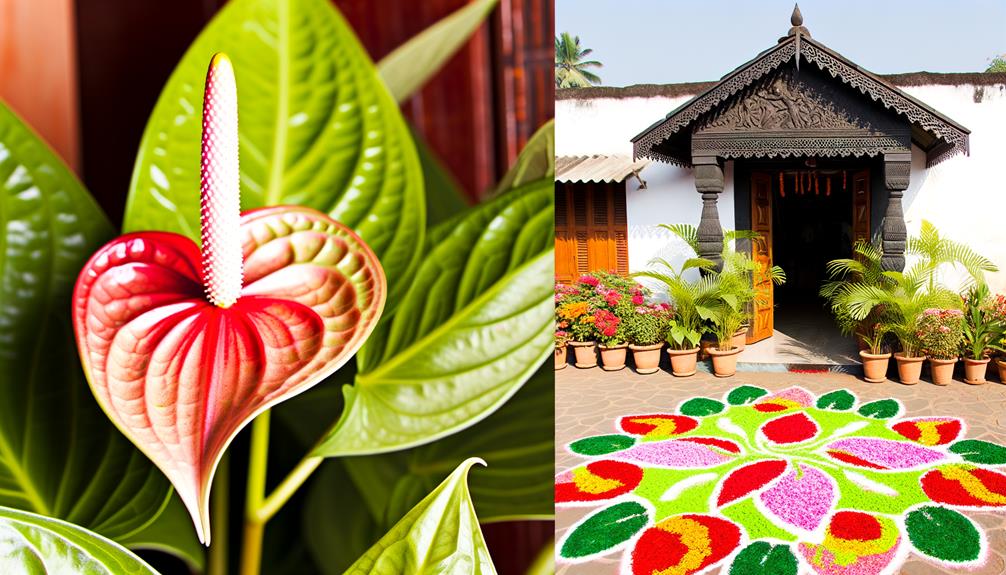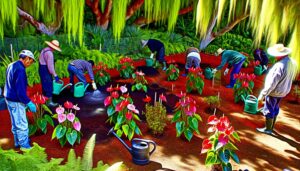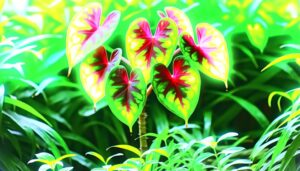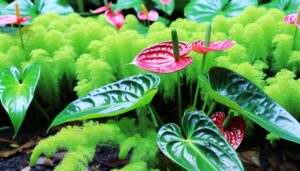Anthurium Flower Meaning and Significance in Marathi Culture
In Marathi culture, the Anthurium flower symbolizes purity, hospitality, and prosperity. Its pure and enduring bloom reflects moral integrity and auspicious beginnings, especially prominent in wedding ceremonies.
The flower's welcoming structure embodies the essence of Marathi hospitality, while its vibrant appearance signifies prosperity. You'll often find Anthuriums enhancing religious ceremonies, festivals, and artistic expressions, each use carrying deep cultural meanings.
Whether adorning altars or enriching festive decor, the flower remains a beautiful symbol of Marathi values and traditions. To fully appreciate its significance, consider exploring its multifaceted role in these cultural practices.

Key Takeaways
- Anthurium flowers symbolize purity, hospitality, and prosperity in Marathi traditions.
- In Marathi weddings, they signify auspicious beginnings and values, enhancing decor and bridal elements.
- Used in religious ceremonies to symbolize divine blessings, purity, and spiritual connection.
- Enhance festive decorations, symbolizing celebration, prosperity, and cultural richness.
- Prominently featured in Marathi art, symbolizing beauty, resilience, and cultural heritage.
Symbolism in Marathi Traditions
In Marathi traditions, the Anthurium flower holds profound symbolic significance, representing purity, hospitality, and prosperity.
When you explore this cultural symbolism, you'll see how each trait reflects core values. Purity embodies moral integrity, a principle deeply embedded in Marathi customs.
Hospitality, a cherished virtue, is symbolized by the flower's open, welcoming structure, reminding you to embrace guests warmly.
Prosperity connects with the flower's vibrant, enduring bloom, reflecting a wish for flourishing life and success.
These meanings aren't just abstract; they influence everyday practices and social interactions. By understanding the Anthurium's symbolism, you gain insight into the cultural fabric that shapes Marathi identity, enriching your appreciation of these traditions.
Role in Weddings
Marathi weddings frequently incorporate the Anthurium flower to symbolize the auspicious beginnings and deep-rooted values that the union represents. You'll notice these vibrant blooms in various aspects of the ceremony, including the decor and bridal bouquets. Their striking appearance adds a touch of elegance while conveying heartfelt emotions.
Here's a quick look at how Anthurium flowers are used in Marathi weddings:
| Aspect | Usage | Significance |
|---|---|---|
| Decor | Centerpieces and altar adornments | Symbolizes purity and prosperity |
| Bridal Bouquets | Integral part of floral arrangements | Emphasizes beauty and commitment |
| Garlands | Used in Varmala ceremony | Represents mutual respect and love |
| Invitation Design | Featured in wedding cards | Signifies warmth and welcome |
| Gift Wrapping | Adorned on gifts | Denotes blessings and good wishes |
Understanding these elements enriches your appreciation of Marathi cultural traditions.
Presence in Religious Ceremonies
You'll often find Anthurium flowers playing an important role in various religious ceremonies, symbolizing purity and divine blessings.
In Marathi culture, these flowers are frequently used in rituals dedicated to deities, given their striking appearance and vibrant colors. You might see them adorning altars or being offered during prayers, enhancing the spiritual ambiance.
Their heart-shaped spathes are believed to represent divine love and the connection between the earthly and the spiritual domain. By incorporating Anthuriums, you're not only beautifying the sacred space but also invoking positive energy.
These flowers' unique attributes make them ideal for conveying reverence and devotion, thereby enriching the religious experience with deeper cultural significance.
Use in Festive Decorations
During festive occasions, Anthurium flowers bring a touch of elegance and cultural richness to decorations, symbolizing both celebration and tradition. You'll find these vibrant flowers enhancing the beauty of homes, temples, and public spaces across Maharashtra. Their striking appearance not only adds aesthetic appeal but also conveys deep cultural meanings tied to prosperity and joy.
- Centerpieces: Anthuriums create stunning focal points on tables.
- Garlands: They're woven into garlands for welcoming guests.
- Altar Decor: Placing them on altars signifies reverence.
- Entrance Adornments: Decorating entrances with Anthuriums marks auspicious beginnings.
- Gift Bouquets: They're used in bouquets as tokens of goodwill.
Cultural Significance in Art
Beyond their use in festive decorations, Anthurium flowers also hold a prominent place in Marathi art, where they're often depicted to symbolize beauty, resilience, and cultural heritage. Artists incorporate these vibrant flowers into paintings, textiles, and sculptures to communicate profound cultural narratives.
When you observe Marathi art, you'll notice how the Anthurium's striking form and color capture the essence of nature's elegance and strength, reflecting the community's values. The flower's depiction in art isn't merely decorative; it serves as a visual emblem of endurance and traditional aesthetics.
Conclusion
In Marathi culture, the anthurium flower is like a vivid brushstroke on a traditional canvas, symbolizing love, purity, and celebration.
You've seen its significance in weddings, religious ceremonies, and festive decorations, where it infuses life into every ritual.
By incorporating this vibrant flower, the culture not only celebrates its aesthetic beauty but also its deeper meanings, enriching the tapestry of Marathi traditions with every petal.






